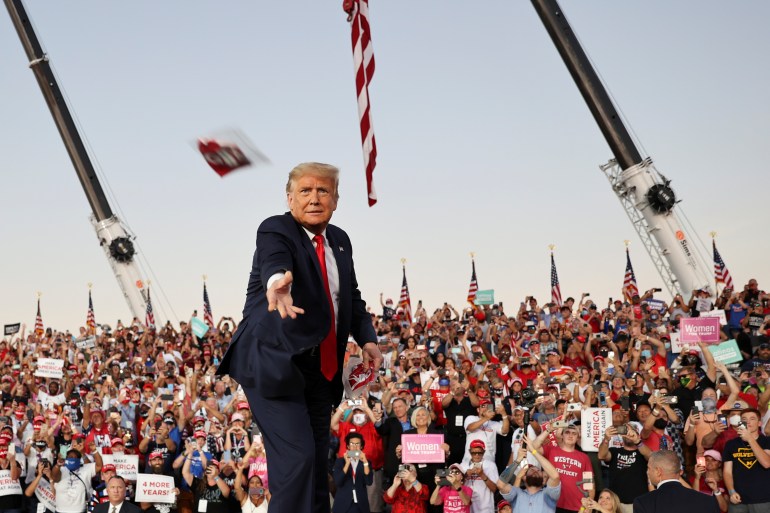![The pandemic has changed how Americans are voting in this year's elections [Nam Y. Huh/AP Photo]](https://www.aljazeera.com/wp-content/uploads/2020/10/AP_20291710614179.jpg?resize=770%2C513)
In February as the Iowa caucuses were getting under way, to kick off the election year, political observers were musing about Donald Trump’s strengths going into the 2020 campaign. He would ride the power of incumbency and a booming economy to November, some argued, potentially against a Democrat whose views were out of the mainstream.
Then the coronavirus pandemic hit. And that has become the prism through which this campaign is viewed
In an already divided United States, COVID-19, and the way Trump and his Democratic opponent Joe Biden are approaching it, have separated Americans further and spawned an election year like no other.
The president’s decision to forgo a nationwide strategy to combat the coronavirus in favour of allowing state governors to form their own plans has allowed him to distance himself somewhat from the response.
Biden has made the virus and Trump’s handling of it a cornerstone of his campaign, reminding voters of the 227,000 and counting Americans who have died.
Trump has repeatedly claimed he has done a “great job” of handling the virus and of focusing on recovery, therapeutics and vaccines in development. But October made it even more difficult for the president to avoid addressing the growing numbers of infections after he contracted COVID-19 and many White House and campaign staffers tested positive – including, just this week, five of Vice President Mike Pence’s top aides.

Voting changes
As of Thursday, over 80 million Americans have voted by mail or early in person, surpassing the 57 million total early votes cast in 2016.
The shift towards early voting has been going on for years, but the shift to mail-in voting has progressed rapidly since this spring’s primaries, when the pandemic first hit and states allowed – and urged – more voters to cast their ballots remotely.
That process was not without its hiccups in several states, leading to ineligible ballots and delayed vote counts. US Postal Service cuts threaten to affect the timely delivery of this election’s ballots, though to this point, many voters are seemingly getting the message and returning their mail ballots well ahead of time, dropping them off at designated drop boxes or taking advantage of voting in person before Election Day on November 3.
All of this has also led to unfounded conspiracy theories about the legitimacy of mail-in ballots, something Trump has embraced – initially as an effort to potentially lower turnout, and when that looked like it was backfiring, to preset a narrative that if he loses, the election is “rigged”.
Amid all of the controversy, many states changed some of their laws to give them more options to count ballots ahead of time. States also tried to relax regulations regarding validating mail-in ballots. Trump and the Republicans have challenged these measures in court with varying success. Given all of the changes and potential hiccups, many state elections officials are expressing optimism about having their vote counts done swiftly.
The exception is Pennsylvania, which, given its complicated rules around mail-in ballots, could take days or weeks to get to a final count. If it’s close in Pennsylvania, this could be significant. It would be even more significant if the country is waiting for Pennsylvania and its 20 electoral votes to give either Trump or Biden a majority in the Electoral College.
Campaign changes
For a while, the pandemic halted large gatherings, but President Trump resumed holding packed rallies beginning with one in Tulsa, Oklahoma in June. After being sidelined for 10 days in the wake of his COVID-19 diagnosis, the president resumed barnstorming battleground states in the final days and packing campaign rallies with mostly maskless, non-socially-distanced supporters.
Biden significantly scaled back the number of in-person events – and all have been socially distanced with some even taking place in parking lots where supporters listen to the event in their vehicles, honking their horns instead of applauding.

Trump’s messaging
Long before the concerns over mail-in ballots – and long before the subsequent surge of voting designed to prevent crowds gathering at polling sites on Election Day – Trump’s initial response to and his eventual handling of the virus has overshadowed everything else during this campaign.
Trump has consistently downplayed the seriousness of COVID-19, promising from the beginning that “it’ll disappear”. Trump, who was weaned on Norman Vincent Peale’s book The Power of Positive Thinking, has applied that sentiment to his public statements throughout, continuing to say “we’ve turned a corner” on the virus, even though that contradicts the data.

The one thing we won’t know until Election Day is how this all affects the final presidential vote, although a Pew Research Center poll revealed the partisanship behind voters’ feelings on the subject.
Eighty-two percent of Biden supporters say that coronavirus will be very important to their vote compared to 24 percent of Trump supporters who say the same. Interestingly, the percentage of Trump supporters who view the virus as very important to their vote has dropped 15 points since August.




Comments
Post a Comment